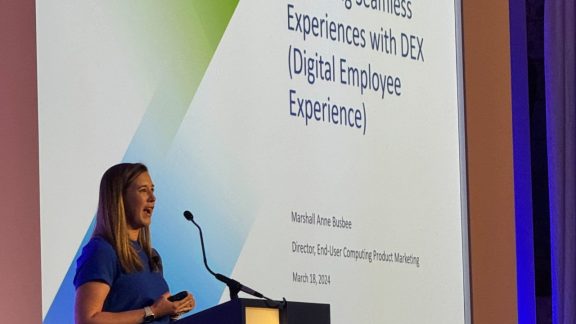By Harry Labana, vice president, products, End-User Computing, VMware
 I’m thrilled with our announcement of the acquisition of Immidio and their user environment management (UEM) solution that provides a consistent and dynamic application and desktop experience across physical, virtual and cloud infrastructures. A hearty congratulations to the Immidio team and a warm welcome to the VMware family! In this post, I’d like to share some additional insight about our strategy and introduce you to what Immidio does and explain how WEM is different from UEM.
I’m thrilled with our announcement of the acquisition of Immidio and their user environment management (UEM) solution that provides a consistent and dynamic application and desktop experience across physical, virtual and cloud infrastructures. A hearty congratulations to the Immidio team and a warm welcome to the VMware family! In this post, I’d like to share some additional insight about our strategy and introduce you to what Immidio does and explain how WEM is different from UEM.
‘Many-ness’ Is Increasing Customer Costs
Most enterprise IT customers I speak with have a mix of physical and virtual infrastructure, invested in automation and open source, begun to consume public cloud infrastructure, and are re-architecting their datacenter strategy towards a hybrid approach. They want everything to run like a cloud service, so they can deploy any app to any device. So how do these enterprises start to move towards that reality for their end-user computing (EUC) service offerings?
In EUC, innovations such as converged infrastructure and flexible delivery architectures are making the day zero problem of deploying desktop and application infrastructure easier and more cost effective. However the day two problem of operating in silos with virtual, physical, and cloud-based desktops is leading to increased complexity. As I meet with EUC customers, it’s staggering to hear how much operational overhead there still is to operate diverse tools, processes and organizations across heterogeneous physical, virtual and cloud infrastructures. A recent article by Goldman Sachs highlights this problem and speaks to what is keeping big companies out of the public clouds:
- “One of the things that’s most misunderstood about enterprise solutions is that most of the cost structure when it comes down to it is not so much for cooling and hardware, but for all the people that it takes to operate at the [service reliability levels] it’s designed for.”
Legacy systems management approaches were not designed to ease this burden. Retrofitting them is extremely cumbersome, costly, time consuming and a high-risk journey, since they try to address all facets of systems management and master none. I am sure you know at least one person with a systems management suite who uses only a fraction of the available functionality to them. J
With traditional approaches it’s worth considering, how much value is being derived? What are people actually doing and how well? Will bloated legacy approaches evolve fast enough to address rapidly evolving needs?
In a time of exponential change and upheaval in the software industry, new approaches will need to emerge to enable customers to operate diverse EUC infrastructures. Our belief is that solutions will need to be more focused and simple to use. Our broader vision is to simplify IT by enabling them to deliver a consistent and secure workspace experience.
We are building out that vision across VMware’s End-User Computing portfolio, but specifically today we are introducing Workspace Environment Management.
I’m Confused, Isn’t Workspace Environment Management Just UEM?
To answer this question, it’s important to first understand what UEM is.
UEM is a combination of technologies that offers granular and dynamic policy management to enable better IT compliance and persona management to customize the user experience.
Often people confuse UEM to be simple profile management included with Windows. If they are more sophisticated, they may still not appreciate that policy can be applied contextually based on different conditions to meet diverse IT and user needs. As illustrated below, location based policy can be applied based on many different conditions. In the demo video below, an example is shown.
UEM is part of Workspace Environment Management. Tell me more.
Workspace Environment Management is an end-to-end approach to application and end-user management across physical, virtual and cloud-hosted environments.
The key three capabilities and benefits of WEM are:
- App Delivery and Isolation – Deliver and manage applications in real-time, while reducing storage costs
- End-to-End Monitoring – Better user experience with proactive alerts and metrics
- User Persona and Dynamic IT policies – Simplified profile and policy management with personalized access across devices and locations for end-users
With these capabilities, it becomes simpler to produce, deliver and consume application as a service across physical, virtual and cloud-based desktops.
This approach enables IT organizations to isolate and deliver applications in real-time, monitor performance and support personalization and policies to best meet diverse end user requirements. Along with App Volumes and vRealize Operations Manager, Immidio adds personalization and dynamic policy to VMware’s portfolio and enables VMware to uniquely offer a best of breed WEM solution that is focused on enterprise needs.
Why Did We Pick Immidio Over Others?
In short, it boiled down to simplicity and enterprise traction. Our internal testing showed great performance. Further analysis showed enterprise customers using the product at scale with existing staff at low to reduced overheard. These same customers loved the simplicity and ability to use their existing infrastructure. To be blunt, it’s remarkable the size of customers that Immidio has won with active production deployments.
We also learned that the vast majority of customers used UEM for persona and dynamic policy management, even the big hairy enterprise ones. Some will wonder why we didn’t pick a solution with user rights management.
Our analysis showed that customers choose to purchase rights management from many partners. We also heard from many customers that rights management can add significant complexity and stability issues to customer environments and most prefer to use native Windows capabilities. VMware will focus instead on simplicity and enterprise grade capabilities to enhance WEM and work with our vast partner network to support additional use cases.
Immidio Demo
Immidio Flex+ is a User Environment Management (UEM) solution which contains a lot of functionality. In this short demo video we illustrate some of the dynamic functionality around application management and some User Environment elements, which can be managed with this UEM solution. An explanation of what is shown in the demo is provided below.

The first part, we illustrate the instant adaption of the user environment at application launch and exit for which both an application specific printer and network drive will be mapped once the application is being launched. Traditionally, if a user needs a specific network resource for a specific application, one automatically maps this resource at logon. The Flex+ UEM approach only attaches network resources (and even manages other application specific elements) when the application is actually going to be used, at launch. This decreases logon times drastically, since fewer operations need to take place at logon and provides you with a true application centric management approach. As you can see network resources can also be detached at application exit.
The second part of the video illustrates the persistence of personal application settings instantly when launching and closing applications. This also occurs independent from the underlying operating system and Windows user profile. This specific user is “roaming” personal application settings back and forth between Windows 7 and Windows 8.1. This functionality can also be used to roam application settings to and from RDSH and Citrix XenApp environments and also works with many popular application delivery (and virtualization) solutions, including App Volumes. This functionality also improves logon times, since there is no longer the need to load application settings at logon. And again, even for personalization Flex+ UEM provides an application centric approach.
The third and last part of the video illustrates the provisioning of a contextual user environment and how an existing session can dynamically be adapted. In this case a member of the Sales EMEA department is logged on and has a very limited user environment (no printers, shortcuts, wrong file type association for PDF). In the Flex+ Management Console this ‘Sales EMEA’ group is added to the Corporate Sales workspace. The user then unlocks his workstation, which in this case triggers a refresh, and the user gets all relevant shortcuts, printers and PDF file type association instantly.
Digging A Little Deeper Into Immidio
Immidio is simple by design, and it’s worth understanding the core components of the product as they are today.
- FlexEngine – Part of the Flex+ client component that needs to be installed on all computers that are managed by Flex+. You can install the FlexEngine on physical desktop and laptops, but also on VDI desktops and terminal servers.
- SyncTool – The SyncTool provides synchronization capabilities mostly targeted at laptop users and to users connected to a network with limited bandwidth. It synchronizes profile archives and the central configuration files, offering users the capability to work offline.
- Active Directory – The easiest way to configure the FlexEngine is through Group Policy. Templates are provided in both .ADM and .ADMX formats.
- Central Config share – This is the Flex+ configuration share that contains the complete Flex+ configuration, which consists mainly of .XML and .INI files.
- Network folder per user – This is the Flex+ profile archive share, it contains the profile archives, backups and log files of all the users. The share contains mostly .ZIP files, the so-called Flex+ profile archives.
- Management Console – Administration console which can be installed on any desktop or Terminal Server from which you want to manage the Flex+ environment.
- Application Profiler – The Application Profiler is a standalone application that greatly simplifies the creation of Flex configuration files and predefined settings for use with Immidio Flex+.
- Helpdesk Support Tool – The Helpdesk Support Tool provides support capabilities for profile archives and profile archive backups through an intuitive graphical user interface. It also provides some analysis functionality by displaying total profile archive sizes for a user and an integrated FlexEngine log file viewer.
Stay Tuned
I am very excited to have this solution join the VMware End-User Computing product portfolio to bring to life our Workspace Environment Management solution offering. Stay tuned for updates on an early access program and our integration progress. If you are interested in being part of the early access program, send an email to [email protected]. We believe the solution will address many of the challenges our customers face and will help them embrace business mobility in the 21st century.
@harrylabana











